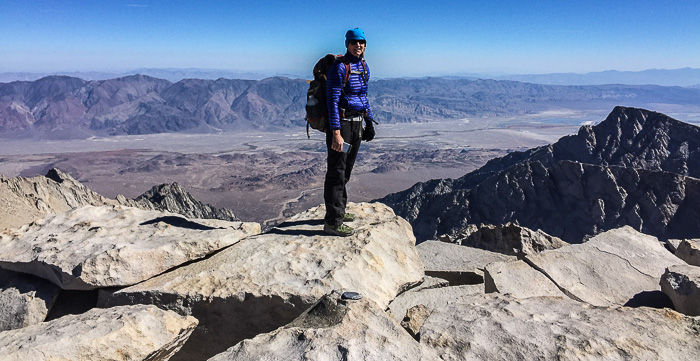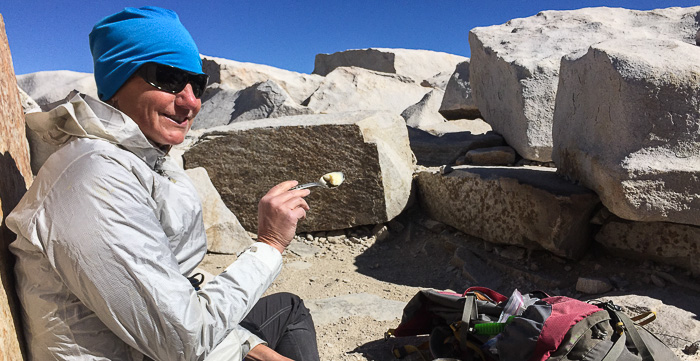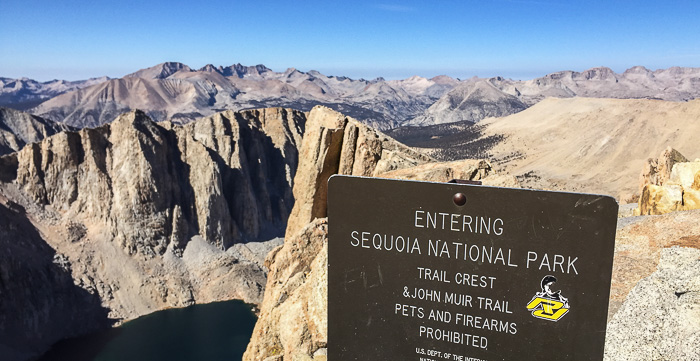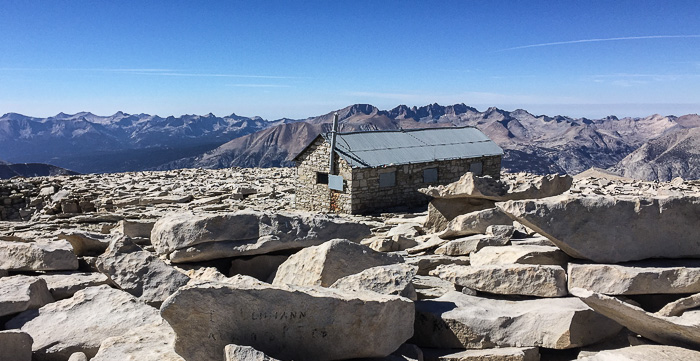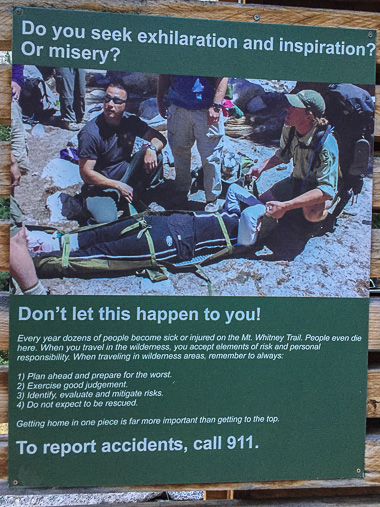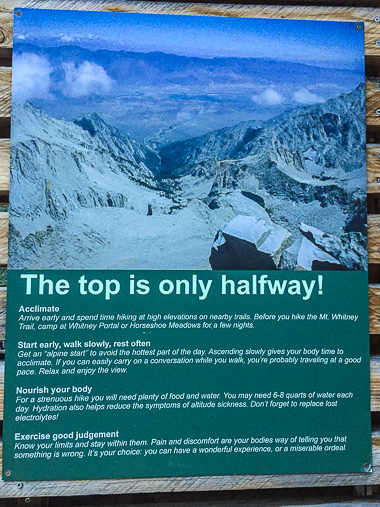Climbing Mt. Whitney: An epic goal, and one to hold loosely
Fair warning: Two of the quotes in this article are…creatively applied. They’re close, mind you, but a little off from their original intent. They came to me on the climb, though, so maybe I can blame it on the altitude?
Backing up, a friend and I climbed Mt. Whitney in mid-October and it could not have gone better. We trained and acclimated for two full weeks prior to the climb, and when the day arrived, the weather gods supplied clear, sunny skies with no storms on the horizon. The 22-mile climb took us 12 hours, from 6am to 6pm, and though tired at the end, we suffered no injuries or lasting ill-effects.
Looking back, it seems insane, both that I did it (I’m not terribly adventurous and can be pretty risk-averse) and that it went so swimmingly. Karen, my best friend and hiking buddy, gets all the credit for our success, but we’ll circle back to her later. First, the dark side of Whitney.
If you Google ‘mt whitney accidents’ the search returns pages of failed climbs, serious incidents, and tragically, numerous deaths. One of those fatalities occurred the day of our climb. Less than two hours into our hike, a descending hiker shared that a man was believed to have wandered off the trail in the night; search and rescue had been contacted but we were to keep alert for signs of the missing hiker. As the day progressed, we heard bits and pieces of confused information and witnessed helicopters circling and searching. On the descent, we received word that the hiker had died and his body had been recovered.
It was a sad and sobering experience that brought to mind a quote from Elizabeth Gilbert’s Big Magic: Creative Living Beyond Fear which I was reading at the time. In the book, Gilbert describes “the central paradox” of art:
My creative expression must be the most important thing in the world to me (if I am to live artistically), and it also must not matter at all (if I am to live sanely).
Art is absolutely meaningless, and also deeply meaningful. It is nothing, and yet it is everything. I think the same can be said of Mt. Whitney. At the end of the day, it’s just a hike. It’s nothing. And yet on that day, to one man - and to his friends and family - it was everything. My heart goes out to them.
To learn from this tragedy and others like it, perhaps we, as aspiring climbers, should view training as everything - the most important thing in the world - but the climb itself (and the goal of peaking in particular) as nothing. As 38 Special warns:
Just hold on loosely
But don’t let go
If you cling too tightly
You’re gonna lose control
The best laid plans go awry, and circumstances can change quickly on the mountain. Climbers have had to abruptly alter plans for myriad reasons including weather, altitude sickness, injury, fatigue, and time (not enough of it left before dark). If we hold goals and expectations loosely, perhaps it’s easier to make the safest decision in the moment, both for ourselves and our hiking party. If we have to turn back (or hunker down for an uncomfortable night): “It’s a bummer, but hey, you’re still alive.”
And now, the lighter side of Whitney. That last quote was from the HikingGuy. If you read only one thing before hiking Whitney, read his Mt Whitney Hike article, and then read it again. It covers everything from planning and permitting to training and acclimation, and shares photos of the climb from start to finish. Fantastic resource.
And that brings us back to Karen (my fantastic resource), who should seriously start her own hiking/guiding business. She’s deeply experienced with all facts of outdoor adventuring and can plan the heck out of a trip, adeptly assessing ability and crafting activities to suit. I didn’t actually need the HikingGuy article - I had Karen!
Overall, I was surprised at how much of the trail had stable footing and felt totally safe. Of course there was more than one “high consequence” area where a fall would end in disaster. On those parts, I just focused on the trail, hugged the inside wall, and never looked over the edge. I’d be hard-pressed to pick a favorite section of the hike, but the most memorable would have to be the last 1.9 miles from Trail Crest (where the Whitney trail meets up with the John Muir Trail) up to the summit.
At this juncture, everything became exaggerated: the stunning view of Sequoia National Park to the west, howling winds that were oh so cold, a dirt trail that morphed into a pile of jumbled stone with steep drop-offs, and the longest 1.9-mile hike of my life! Other hikers concurred, with one guy lamenting his negative pace (ha!). That darned hut at the top seemed like it would never come into view, but when it finally did…zowie! Pure exhilaration that carried us to the top.
A few practical details about our trek:
Training
We passed three guys hiking up Whitney and when they caught up at the summit, one said, “You two were moving! Did you train for this?” LOL. Yes, we did. We had the luxury of hiking and acclimating for two full weeks prior to the climb. I wrote about those training hikes in this article.
Permit
Since hiking in October, we didn’t have to contend with the Whitney lottery system. Plenty of permits were available, and we picked up a walk-in day use permit at the Eastern Sierra Interagency Visitor Center the day before our climb.
In 2016, there were 13,638 applicants requesting spots for 64,939 people to climb Whitney. Only 100 day hikers and 60 backpackers are allowed each day, so competition for permits can be fierce. This article from the Orange County Register shares insider tips on how to win Mt. Whitney lottery.
Weather/Clothing
I may not have read many articles prior to climbing Whitney, but I checked the weather obsessively in the preceding days and appreciated the detailed information from mountain-forecast.com with forecasts for multiple elevations.
The day we climbed, the summit was forecast for 25 mph winds and a high of 28 degrees F (about 14 degrees with wind chill) but it was 50 degrees at the start. I wore a dri-fit t-shirt and lightweight long-sleeve top at first, but later added a down coat, windshell, knit cap, gloves, and mittens. It was darned cold after Trail Crest (my hands suffered) but we warmed up at the top in a rock enclosure sheltered from the wind. There’s also a stone hut at the summit, but it’s dark in there and we had a brilliantly sunny day so opted to stay outside.
Hydration
Trail Camp Pond is the last good water source on the way up; we filled there on the way up and back. Hydration is key, and to be honest, I didn’t drink enough on the first half, a point that became glaringly obvious when I pulled out my hydration pack for the 2nd refill. For our conditions, I probably should have gone through 4–5 liters. It’s wise to track consumption and drink regularly.
Food
We packed plenty of energy-dense snacks for the day, but it was a stroke of brilliance to carry the JetBoil for hot lunch and drinks at the summit. It was decidedly not brilliant, however, to bring a Backpacker’s Pantry meal to 14,500 feet: the cooking time doubles for every 5,000 feet so the meal would have taken an hour to cook! Ha! Luckily Karen also threw in some flavored Idahoan mashed potatoes. They were done almost instantly and warmed us up from the inside out.
Wag Bags
If nature calls during your Whitney climb, you have to do your solid-waste business in a wag bag, and pack it out. At least you’re supposed to. Throughout the day, we saw a bunch of filled bags resting just off the trail. I was hopeful that hikers were planning to pick them up on the way down, but most were still there on the return. Yikes. There’s no wag bag fairy - gotta pack it out!
In this one instance, we did not have to come prepared; the rangers gave each of us a wag bag when we picked up our day use permit.
If you dream of climbing Whitney, good luck, be safe, and enjoy! When planning the trip, this HikingGuy article is a helpful resource, as are these two documents from the Forest Service:
The Eastern Sierra Interagency Visitor Center (760–876–6200) can provide up-to-date conditions and information.
Mt. Whitney was the hardest hike/climb I’ve ever done given the single-day altitude gain and total mileage. It was an awesome accomplishment, and I’ll be forever grateful that Karen gently nudged me out of my comfort zone and set us up for success with her outstanding planning (training included). Thank you K - you’re the BEST!!
This article is one of many written about a 3-week road trip spent hiking and camping in the Eastern Sierras and Death Valley. To see all articles, check out this trip summary.
A few extra photos:





